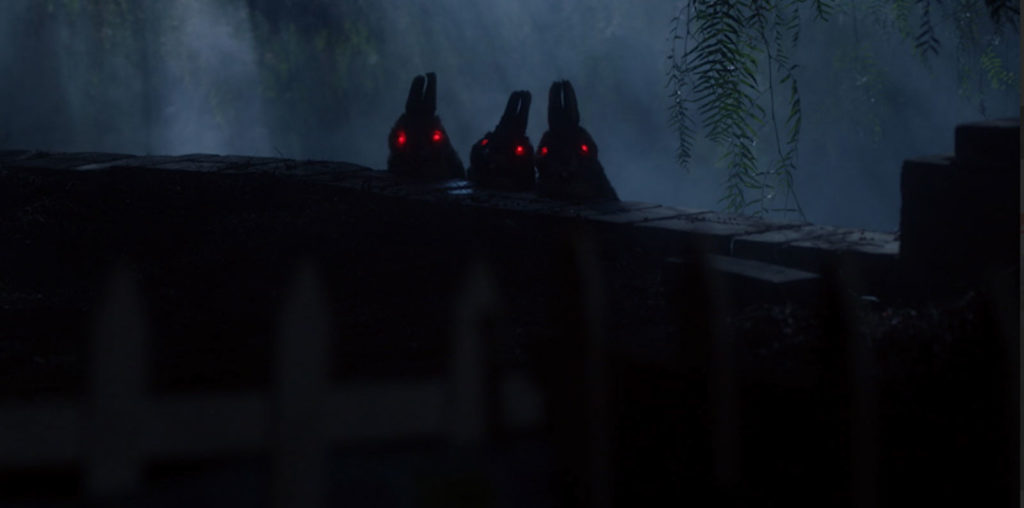
Magic realism, a genre where the waking and dream worlds seamlessly overlap, has been a staple of Latin American literature for decades. Some of the region’s most lauded authors, from Gabriel García Márquez to Isabel Allende, have utilized its techniques to add other wordly dimensions and depth to their expansive work. In cinema, however, fewer filmmakers have successfully employed this tricky and fickle genre in their storytelling. In his curiously engaging new film Marigold the Matador, director Kenneth Castillo boldly throws caution to the wind and uses magic realism to tell this moving story of an isolated girl who befriends a homeless man lost in the trap of mental illness.

“…boldly uses magic realism to tell this moving story.”
Marigold (Maia Kahlo) is an introverted and isolated 11-year old Mexican American girl living with her single mother Lily (Karla Ojeda). Their lot is a tough one. Early on in the film, mother and daughter are seen wheeling their suitcases to yet another shabby rental somewhere in the outskirts of LA. As her mother juggles college during the day and then works long nights at a Mexican restaurant at night, Marigold – who may or may not be in school – is a quintessential latchkey kid left to parent herself. She buys the family groceries, prepares makeshift dinners of bologna sandwiches, and otherwise seems to spend her days adrift in her thoughts. With little dialogue and a spare, yet affecting score, her isolation is made all the more palpable.
Lily, meanwhile, is dealing with demons of her own, She is confronted by her mother (a harridan if ever there was one) at work who – after a barrage of insults – implores Lily to let her see her Marigold.” Just because I was a horrible mother, doesn’t mean I can’t be a good grandmother,” the old woman quips. After this interaction, it’s no wonder that that Lily insists on living such a tough-and-go lifestyle with her daughter.

“…rewards the patient viewer by using the tools of magical realism to tell a simple story.”
At the same time, a disheleved middle age man – clad only in boxers and hospital gown – is thrown out of a medical facility and onto the street (a sad scene that has been played out in real life recently). Identified as only El Toro in the credits, he shouts unintelligibly, clads himself in plastic hefty bags, and aimlessly wanders the mean streets of the City of Angels. Along the way he collects a small wagon and, curiously, a plastic viking helmet – perhaps part of a discarded Halloween costume – which he places atop his head. In a brief but powerful flashback, we see this same man – well groomed and smartly dressed – reflected in a bathroom mirror as her struggles to open a large bottle of an unknown prescription.
Soon enough, Marigold and El Toro’s paths cross. Hearing him rifling through the trash outside her home, Marigold (Mari as her mom calls her) begins leaving food for El Toro. He readily accepts this gift and thus begins a surreal kind of dance as Mari attempts to make contact with this troubled soul. Snorting and pawing the ground much like a deranged bull, El Toro initially tries to frighten Mari away. And here, the filmmaker takes his leap into the aforementioned magic realism. Castillo intercuts scenes of Mari dressed in traditional matador garb with her face painted Dia de Los Muertos style – and El Toro – the viking horned helmet atop his head and his own visage painted like the bull from Picasso’s Guernica – sparring back and forth in the LA aqueduct. These scenes, unlike the rest of the film, are shot in black and white with only the bright hues of Mari’s matador outfit and each characters’ bright face paint breaking the monochromatic color palette. Quiet and evocative, these shots elevate the story line into the supernatural. Eventually matador and bull reach a tenuous peace, and begin sharing lunches together. When the inevitable tragedy occurs, announced by the flashing lights and blaring siren of police car, it is – to quote a title of a celebrated García Márquez novel – much like A Chronicle of a Death Foretold.
For a film with little budget and no “big name” talent, Marigold the Matador is a remarkably strong effort. Where it falters is in its flashforward sequences which portray a beautiful young woman – who speaks nary a word – in a college classroom learning the craft of creative writing. While the functionality of this character makes narrative sense, her character is otherwise criminally underdeveloped and underused. Nonetheless, Marigold the Matador rewards the patient viewer by using the tools of magical realism to tell a simple story in a beautiful and moving manner. One can only wonder what an imaginative and insightful filmmaker like Castillo could do if the given more resources to work with. Here’s hoping he gets the opportunity.

Marigold the Matador (2017) Directed by Kenneth Castillo. Starring Maia Kahlo, Camila Banus, Ivan Basso, and Karla Ojeda.
3 ½ out of 5 stars


Me encanta su Extraordinario Trabajo.. I love It! ???????????? Kenneth Castillo Uno de Los Mejores Directors Diria yo *Mi Predilecto* Exitos Para Usted ✊
So Astonished..A big S/O to your Family.. God bless them.. Great Film.. Congrats to all of you.. Amazing Job…Muy Real y a la vez Imaginacion… Fuerte…interesante..Tierna… Good film pero Muy Corta…me quede Picada ???? me inspiro… Illustra… Es una realidad… Genuine & Unique Film
Director Kenneth Castillo…